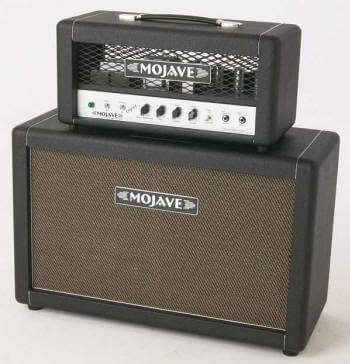Kudos — Excellent response with humbuckers and single-coils. Blendable channels. Variable power.Concerns — None.
Contact — Mojave AmpWorks • (866) 235-6399; www.MojaveAmpworks.com

 Mojave’s Victor Mason has learned much from studying the intricacies of various Ampeg, Marshall, and Vox amps, and the Coyote ($2,500 retail/$2,050 street with Celestion G12-30H) is the summation of his insights into small-amp design.
Mojave’s Victor Mason has learned much from studying the intricacies of various Ampeg, Marshall, and Vox amps, and the Coyote ($2,500 retail/$2,050 street with Celestion G12-30H) is the summation of his insights into small-amp design.
This dual-EL84, cathode-biased amp features dual independently voiced channels, which are labeled Bass Volume and Treble Volume. Each controls the two triode gain stages of a 12AX7, and the idea is that you use varying levels of each to obtain not just the amount of overdrive you want, but also the balance of bass and treble needed for your particular guitar. This dual-function system obviates the need for separate tone controls, and the only additional EQ on the Coyote is a Tone knob and 2-position Mid Cut/Emphasis switch.
Ditching the standard master volume, the Coyote features a Power Dampening control that allows you to vary the output wattage continuously over a range of less than 1 watt to a herkin’ 12 watts. By controlling the drive voltage that feeds the output stage, Power Dampening provides an efficient way to operate the amp at different loudness levels, with a side benefit of cooler running and extended life for the tubes and transformers. The Coyote is also the only amp in the group to be equipped with a variable-level line out, which incorporates a push-pull ground lift to overcome ground loop-induced hum when connecting to external gear. Sweet.
 The Coyote’s Bass and Treble knobs are also the preamp gain controls, so it’s kind of like using an old Marshall with the bright and normal channels jumpered. Depending on which input you plug into, the Coyote readily offers up a good selection of stout clean and overdriven tones. The Low Sensitivity input works great with humbuckers if clean is your primary objective, but I tended to stick with the High input for all my test guitars, with good overall results. Even with humbuckers, getting a hot distortion sound with the Power Dampening knob set on the low side (say, the 2 to 4 watts range) requires that you run the Bass and Treble knobs close to wide open. The tones are pretty well balanced with both of these knobs at or close to equal settings, and any further EQ refinement can be done with the Tone knob.
The Coyote’s Bass and Treble knobs are also the preamp gain controls, so it’s kind of like using an old Marshall with the bright and normal channels jumpered. Depending on which input you plug into, the Coyote readily offers up a good selection of stout clean and overdriven tones. The Low Sensitivity input works great with humbuckers if clean is your primary objective, but I tended to stick with the High input for all my test guitars, with good overall results. Even with humbuckers, getting a hot distortion sound with the Power Dampening knob set on the low side (say, the 2 to 4 watts range) requires that you run the Bass and Treble knobs close to wide open. The tones are pretty well balanced with both of these knobs at or close to equal settings, and any further EQ refinement can be done with the Tone knob.
The Coyote works superbly with single-coils, as you can ratchet up the Bass knob to set the gain to a happening point, and then inch up the Treble control until the brightness is just where you want it (or the other way around, if you so prefer). Using the Coyote at or near its maximum output level changes the ball game a bit, because now the power amp is adding its own overdrive content, which is considerable. In this mode, the Coyote shows its teeth as it churns out thick, harmonics-laden grind. Elements of its sound are reminiscent of an old Marshall 20 watters, but the Coyote has a broader palette of textures to play with, and it seems to instinctively want to sound good with just about any guitar.
Bottom line: If you like the idea of exploring very interactive control nuances for precise tailoring of your tones, you’ll find the Coyote a fun and exciting critter to add to your tone zoo.
Kudos — Excellent response with humbuckers and single-coils. Blendable channels. Variable power.Concerns — None.
Contact — Mojave AmpWorks • (866) 235-6399; www.MojaveAmpworks.com
Source: https://mercurymagnetics.com/pages/news/GuitarPlayer/GPFeb06.htm